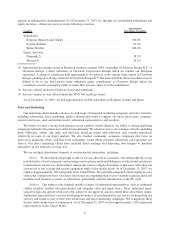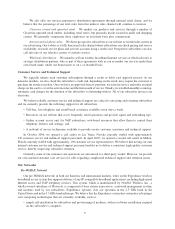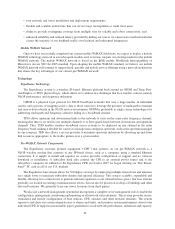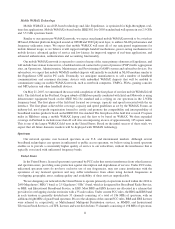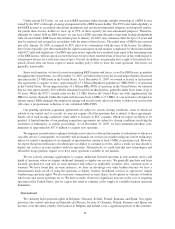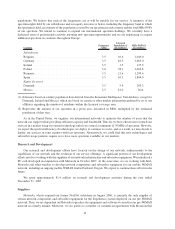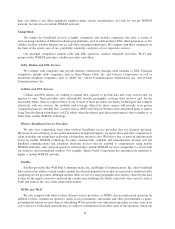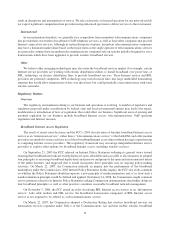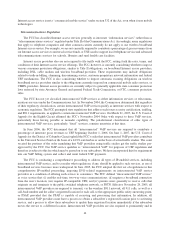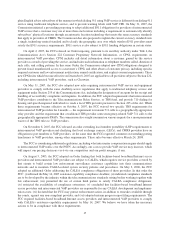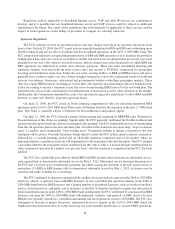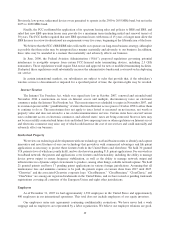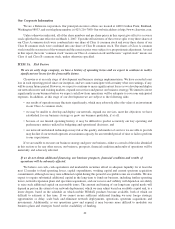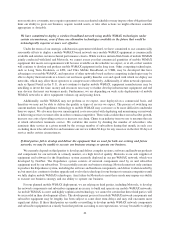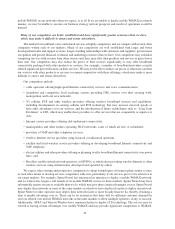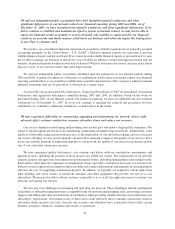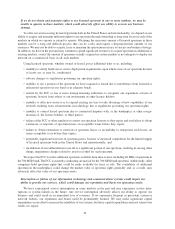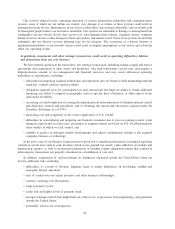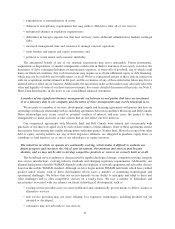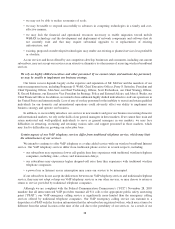Clearwire 2007 Annual Report Download - page 26
Download and view the complete annual report
Please find page 26 of the 2007 Clearwire annual report below. You can navigate through the pages in the report by either clicking on the pages listed below, or by using the keyword search tool below to find specific information within the annual report.Regulatory policies applicable to broadband Internet access, VoIP and other IP-services are continuing to
develop, and it is possible that our broadband Internet access and VoIP services could be subject to additional
regulations in the future. The extent of the regulations that will ultimately be applicable to these services and the
impact of such regulations on the ability of providers to compete are currently unknown.
Spectrum Regulation
The FCC routinely reviews its spectrum policies and may change its position on spectrum allocations from
time to time. On July 29, 2004, the FCC issued rules revising the band plan for BRS and EBS and establishing more
flexible technical and service rules to facilitate wireless broadband operations in the 2495 to 2690 MHz band. The
FCC adopted new rules that (i) expand the permitted uses of EBS and BRS spectrum so as to facilitate the provision
of high-speed data and voice services accessible to mobile and fixed users on channels that previously were used
primarily for one-way video delivery to fixed locations; and (ii) change some of the frequencies on which BRS and
EBS operations are authorized to enable more efficient operations. These new rules streamlined licensing and
regulatory burdens associated with the prior service rules and created a “PCS-like” framework for geographic
licensing and interference protection. Under the new rules, existing holders of BRS and EBS licenses and leases
generally have exclusive rights over use of their assigned frequencies to provide commercial wireless broadband
services to residences, businesses, educational and governmental entities within their geographic markets. These
rules also require BRS licensees, including us, to bear their own expenses in transitioning to the new band plan and,
if they are seeking to initiate a transition, to pay the costs of transitioning EBS licensees to the new band plan. The
transition rules also provide a mechanism for reimbursement of transaction costs by other operators in the market.
Additionally, the Commission expanded the scope of its spectrum leasing rules and policies to allow BRS and EBS
licensees to enter into flexible, long-term spectrum leases.
On April 21, 2006, the FCC issued an Order adopting comprehensive rules for relocating incumbent BRS
operations in the 2150 to 2162 MHz band. These rules will further facilitate the transition to the new 2.5 GHz band
plan. This Order is currently subject to Petitions for Reconsideration and judicial appeal.
On April 27, 2006, the FCC released a further Order revising and clarifying its BRS/EBS rules. Petitions for
Reconsideration of this Order are pending. Significantly, the FCC generally reaffirmed the flexible technical and
operational rules upon which our systems are designed and operating. The FCC clarified the process of transitioning
from the old spectrum plan to the new spectrum plan, but reduced the transition area from large “major economic
areas,” to smaller, more manageable “basic trading areas.” Proponents seeking to initiate a transition to the new
band plan will be given a 30-month timeframe within which to notify the FCC of their intent to initiate a transition,
followed by a 3-month planning period and an 18-month transition completion period. In markets where no
proponent initiates a transition, licensees will be permitted to self-transition to the new band plan. The FCC adopted
a procedure whereby the proponent will be reimbursed for the value it adds to a market through reimbursement by
other commercial operators in a market, on a pro-rata basis, after the transition is completed and the FCC has been
notified.
The FCC also clarified the procedure by which BRS and EBS licensees must demonstrate substantial service,
and required them to demonstrate substantial service by May 1, 2011. Substantial service showings demonstrate to
the FCC that a licensee is not warehousing spectrum, but rather is using the spectrum to provide actual service to
subscribers. If a BRS or EBS licensee fails to demonstrate substantial service by May 1, 2011, its license may be
canceled and made available for re-licensing.
The FCC reaffirmed its decision to permit mobile satellite service providers to operate in the 2496 to 2500 MHz
band on a shared, co-primary basis with BRS licensees. It also concluded that spectrum sharing in the 2496 to
2500 MHz band between BRS licensees and a limited number of incumbent licensees, such as broadcast auxiliary
service, fixed microwave, and public safety licensees, is feasible. It therefore declined to require the relocation of
those incumbent licensees in the 2496 to 2500 MHz band. Additionally, the FCC reaffirmed its conclusion that BRS
licensees can share the 2496 to 2500 MHz band with industrial, scientific, and medical, or ISM, devices because
ISM devices typically operate in a controlled environment and use frequencies closer to 2450 MHz. The FCC also
reaffirmed its decision to permit low-power, unlicensed devices to operate in the 2655 to 2690 MHz band, but
emphasized that unlicensed devices in the band may not cause harmful interference to licensed BRS operations.
18


